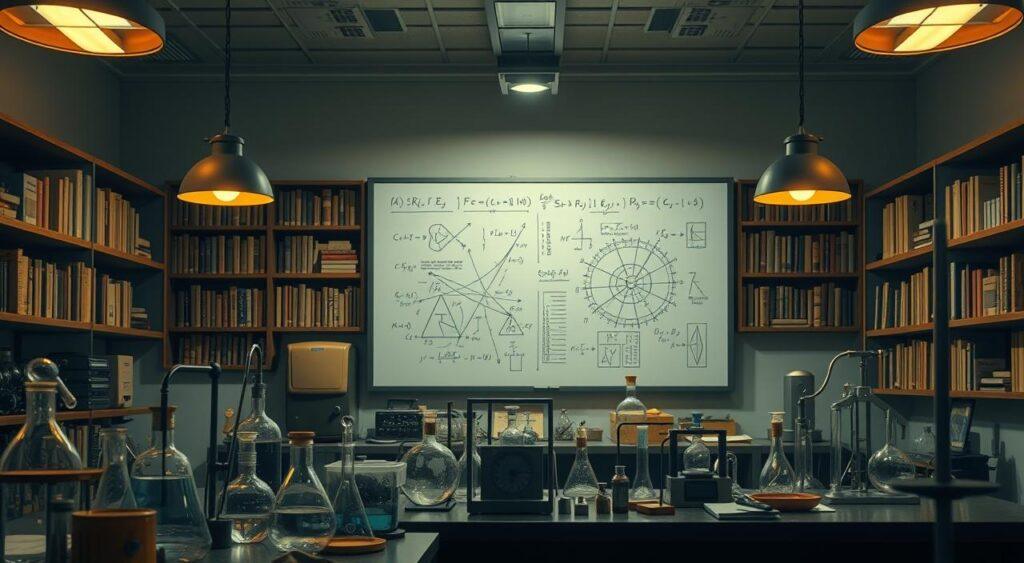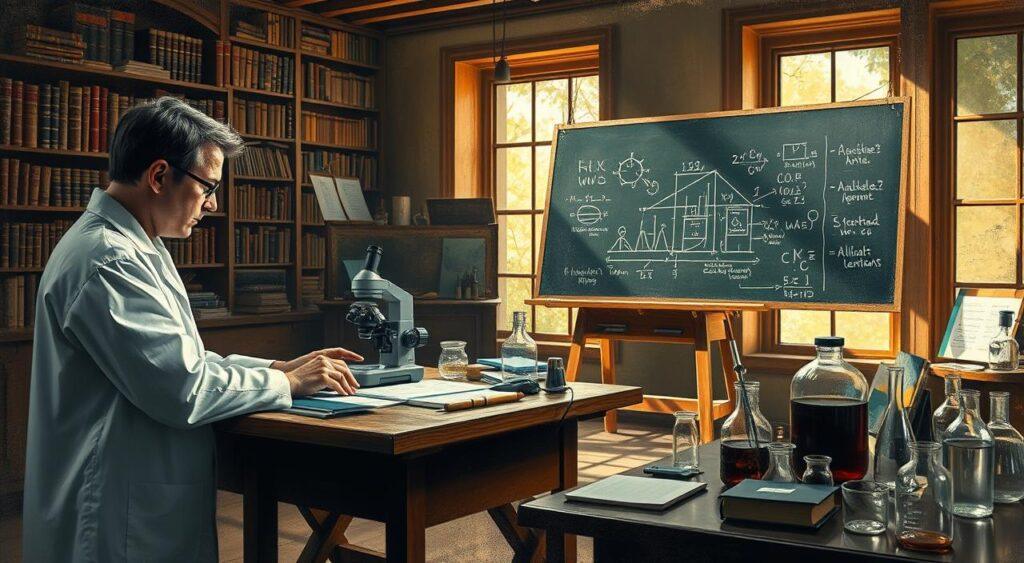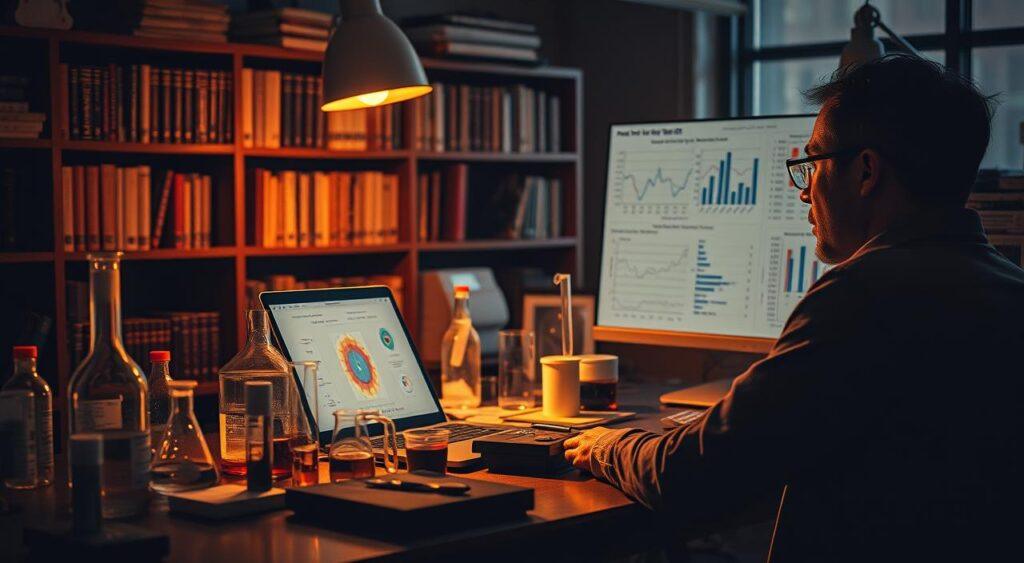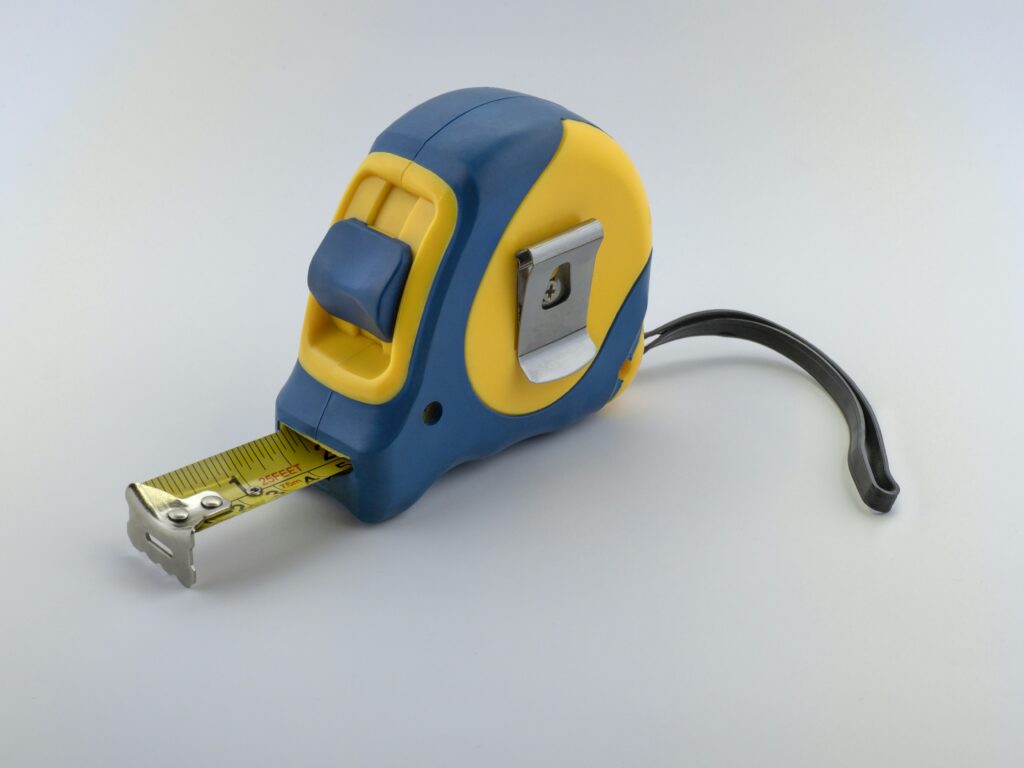Ever wondered how scientists unlock nature’s secrets? It’s the scientific method. A structured process refined over centuries. This approach guides curious minds from questions to discoveries through careful steps.
Imagine troubleshooting Wi-Fi issues at home. You observe the problem, guess causes, then test solutions. That’s the scientific method in action—a mental model anyone can use!
This example illustrates how the method works as a framework for solving problems.
Historians trace its roots to thinkers like Aristotle and Francis Bacon. They showed how systematic observation and hypothesis testing reveal patterns in the history of scientific inquiry. Today, this method helps businesses optimize websites and farmers grow healthier crops.
Why does it work? By controlling variables and avoiding bias, results become reliable. Whether fixing tech glitches or launching products, this framework turns hunches into actionable insights, enhancing our knowledge.
Ready to see how it applies to your daily challenges to the scientific method?
Key Takeaways
- The scientific method is an empirical process developed through centuries of refinement.
- Relies on systematic observation and analysis in science
- Used in tech troubleshooting, business decisions, and everyday problem-solving methods
- Cycle of hypothesis testing leads to improved understanding of concepts
- Historical contributors include Ibn al-Haytham and Charles Darwin, shaping our knowledge
- Emphasizes controlled experiments to minimize bias in scientific analysis
- Enhances decision-making through measurable results in various topics
Introduction to Scientific Mental Models
Have you ever thought like a scientist? Not with lab coats or microscopes, but by using mental shortcuts to crack tough puzzles. These frameworks—called mental models—act like cheat sheets for understanding complex ideas in science and beyond.
Why do these models matter? They turn messy data into clear patterns. Imagine fixing a bike chain. You test theories (“Is the gear loose?”) before buying new parts. That’s hypothesis testing—a core part of structured thinking.
Here’s how they work:
- Spot patterns in chaos
- Guess causes (hypothesis creation)
- Test ideas through simple checks
Teachers use these mental models to explain photosynthesis. Engineers apply them to design apps. Even kids use basic versions when troubleshooting video game glitches.
By organizing research and data, these tools make methods feel less intimidating, especially when exploring the scientific method and its history. The development of knowledge through observation and explanation is crucial in these processes.
Next time you face a challenge, ask: “What would a researcher try first?” Often, the answer lies in breaking big topics into testable chunks. Your kitchen experiments with baking times? That’s science in disguise!
The Historical Evolution of Scientific Inquiry

What sparked humanity’s journey from guesswork to groundbreaking discoveries? Our story begins with clay tablets and papyrus scrolls – tools early thinkers used to document patterns in nature.
Foundations in Ancient and Medieval Thought
Babylonian star charts (1000 BCE) tracked planetary movements using math. Egyptian medical scrolls like the Ebers Papyrus documented patient data for future reference. Greek philosophers took it further – Aristotle compared dolphin anatomy to land mammals, while Epicurus urged followers to question everything.
Medieval scholars added crucial pieces:
- Al-Haytham’s light experiments with dark rooms
- Al-Biruni’s insistence on repeating tests
- Avicenna’s drug trials using control groups
The Scientific Revolution and Enlightenment

Galileo’s inclined planes revealed motion laws through timed rolls. Newton famously said, “I stand on giants’ shoulders” – acknowledging centuries of organized research traditions. Coffeehouse debates birthed peer review, while royal societies funded repeatable tests.
Three shifts changed everything:
- From philosophical debates to measurable data
- Private journals becoming shared knowledge
- Tools like microscopes expanding observable worlds
What lessons emerge? Progress thrives when curious minds build on past work – just like your phone apps improve through updates. Which historical breakthrough surprises you most?
Foundations of The Scientific Method
How do breakthrough ideas transform into trusted truths? The answer lies in three sturdy pillars: testable hypotheses, systematic checks, and learning from what works. Imagine your oven burns cookies every time.
You’d guess reasons (“Is the temp too high?”), then adjust settings. That’s hypothesis-driven thinking!
Forming clear hypotheses acts like a roadmap. Start with observations – what’s happening? Next, create an educated guess you can actually test.
Ancient thinkers like Aristotle showed this works: he studied seashells on mountains to theorize landforms change over time.
Here’s how this process builds knowledge:
- Spot patterns (why do plants lean toward windows?)
- Design checks (rotate pots daily for a week)
- Refine ideas based on results
Early astronomers used similar steps. They tracked star movements, predicted eclipses, then adjusted models when predictions missed. Each cycle made their understanding sharper. Today, app developers use A/B tests the same way – try features, measure clicks, improve designs.
What keeps this process honest? Repeatable tests and openness to being wrong. Francis Bacon noted centuries ago: “Nature answers only when properly questioned.” Modern labs still follow that wisdom, proving good foundations stand the test of time.
Key Principles of The Scientific Method

What makes discoveries stick around for centuries? Three rules keep knowledge reliable: watch closely, guess smart, and check often. Think of it like perfecting grandma’s cookie recipe—tweak ingredients until you nail that crispy edge.
Observation, Hypothesis, and Testing
Spotting patterns comes first. Early astronomers noticed stars moving predictably. Al-Haytham tested light behavior in dark rooms. Today, app developers track user clicks like stargazers tracked constellations.
Guesses must be testable. Newton didn’t just think apples fell—he calculated gravity’s pull. Try this: predict how long your commute takes tomorrow. Then time it. That’s hypothesis testing in your driveway!
Iteration and Peer Review
Early researchers shared findings at coffeehouses. Now journals use group checks to catch errors. Picture baking a cake—friends taste-test each version until it’s just right.
Why does this work? Multiple eyes spot missed details. In the 1970s, Feynman pushed scientists to share failed tests too. This honesty helps everyone improve ideas faster.
Ever fixed a bike chain through trial and error? That’s iteration! Each adjustment gets you closer to smooth pedaling. Modern labs do the same—tweak experiments based on feedback until results hold up.
Step-by-Step in The Scientific Method
How do everyday mysteries become solved puzzles? Picture a curious student wondering why leaves change color. Their journey mirrors what pioneers like Francis Bacon championed—breaking big questions into bite-sized experiments.
Defining a Question and Gathering Data
Start simple. A baker might ask: “Why does bread rise unevenly?” Early thinkers like Isaac Newton did similar detective work—his prism experiments began with “Why does light split into colors?”
This inquiry reflects the essence of the scientific method and the development of hypotheses.
Gathering facts comes next in the process of the scientific method. Track temperatures, measure ingredients, or count bird migrations. Historical breakthroughs in science often started with notebooks full of observations.
One farmer’s crop records from 1600s England later helped explain plant growth cycles, illustrating the history of scientific inquiry.
Analyzing Results and Drawing Conclusions
Numbers tell stories. When Newton studied gravity, he compared apple drops to moon orbits. Patterns emerged through math—just like comparing cookie batches to find the perfect bake time.
Francis Bacon urged thinkers to “torture nature until she confesses.” Modern labs use spreadsheets instead of dungeons, but the goal remains: separate lucky guesses from reliable truths.
Did rotating plants daily fix their leaning? Charts will show the answer.
What step would you tackle first—questioning, testing, or number-crunching? Share your favorite phase in this never-ending dance of discovery!
Observation and Hypothesis: The Starting Point

How do great discoveries begin? With eyes wide open and a curious mind. Picture a biologist spotting monarch caterpillars munching only milkweed leaves. That simple observation sparks questions—why this plant? What makes it special in the context of scientific reasoning?
Karl Popper taught us that guesses must be testable hypotheses. Like noticing your fridge feels warm. You might think: “Is the compressor broken?” That’s a hypothesis! Ancient thinkers used similar logic. Aristotle wondered why seashells appeared on mountains, leading to early theory about land changes in the history of scientific thought.
Here’s how observation builds knowledge in the scientific method:
- Track patterns (plants leaning toward light)
- Ask “Why?” or “What if?”
- Create checks anyone can repeat
Modern examples work the same way. Test if drinking water before bed increases bathroom trips. Record data for a week. Results either support your guess or send you back to observing the nature of the problem.
Popper’s big idea? Good hypotheses can be proven wrong. Imagine two chefs arguing over cookie recipes. The best way to settle it? Bake both batches and compare. That’s how theory grows into reliable knowledge through the scientific method.
What puzzle have you solved through watching and guessing? Your kitchen experiments might be closer to research than you think!
Experimentation and Data Analysis

How do smart experiments turn guesses into facts? Picture a gardener testing plant food. They might grow tomatoes in three plots: one with extra nutrients, one with regular soil, and one with none. This simple setup reveals what works through observation and comparison.
Designing Tests That Speak Truth
Good experiments control variables like a chef controls heat. When a sports team tests ticket prices, they might change costs for Friday games but keep Saturday prices steady.
This isolates one factor—just like adjusting oven temp while keeping cookie dough identical.
Here’s what makes checks reliable:
- Clear comparisons (Group A vs. Group B)
- Repeatable steps anyone can follow
- Tools like spreadsheets to track patterns
Ever tracked sleep quality after cutting caffeine? That’s data collection! Modern scientists use similar logic in labs—recording results in tables before creating graphs. A bakery might test two cupcake recipes, counting sales to see which wins.
Analysis turns numbers into stories. If raising ticket prices lowers attendance, charts show the trend. But what if rainy nights skew results? That’s why multiple trials matter—like baking several cookie batches to confirm perfect bake time.
What makes an experiment reliable in your life? Maybe testing commute routes or streaming services.
Share your favorite example of turning hunches into proof!
Integrating Historical Insights into Modern Science

How does yesterday’s wisdom shape today’s breakthroughs? Ancient thinkers laid tracks that modern trains of thought still follow. Their approaches to reasoning and problem-solving echo in labs and boardrooms worldwide.
Lessons from Aristotle to Newton
Aristotle’s studies of living organisms emphasized observing nature firsthand—a practice now standard in field biology. Centuries later, Newton transformed these observational roots into mathematical reasoning processes, proving apples and planets follow the same gravitational rules.
Three key connections bridge past and present:
- Controlled experiments (inspired by medieval repeatability standards)
- Data-driven conclusions (echoing Bacon’s empirical focus)
- Peer feedback loops (evolved from royal society debates)
Urban planners studying climate patterns often reference medieval flood records—combining old observations with new tech. Biologists still use Darwin’s notebook strategies when tracking species adaptations.
Modern labs achieve consistent results by blending Newton’s “no hypotheses without proof” rule with Aristotle’s pattern-seeking. Next time you analyze spreadsheet data, remember: you’re using tools refined through 2,300 years of trial and error!
How do you think past discoveries shape our current experiments? Whether testing marketing campaigns or perfecting coffee blends, historical methods for analyzing experimental data remain surprisingly relevant.
Incorporating Hypothesis Testing and Prediction in Research
What separates wild guesses from real breakthroughs? Testing predictions bridges ideas to truth. Picture Pavlov’s dogs—he predicted bells would trigger drooling if paired with food. His experiments proved it, showing how structured checks reveal hidden patterns.
Why is testing so vital? It’s like tasting cookie dough before baking. You adjust sugar levels based on results—no more burnt batches! Researchers use similar logic in the scientific method.
A botanist might predict seeds need sunlight to sprout. They’ll plant some in light, others in dark, then compare growth.
Three steps make this method work:
- State clear predictions (“If X happens, then Y follows”)
- Design checks that isolate variables
- Measure outcomes objectively
Teens testing sleep’s impact on productivity mirror lab practices in the history of scientific inquiry. Tracking hours slept versus tasks completed turns hunches into data.
Historians found medieval doctors used this approach—recording patient recoveries to refine treatments.
Experimentation uncovers truth by cutting through biases. Imagine two chefs arguing over oven temps. The solution?
Bake identical batches at different heats and compare. That’s how hypotheses become reliable knowledge—one measured result at a time.
Ever adjusted your commute based on traffic apps? You’re using prediction models similar to research frameworks. Each test—whether in kitchens or labs—builds a clearer picture of how our world works.
Peer Review and Iterative Processes in Scientific Inquiry

How do good ideas become great discoveries? Picture a chef perfecting a recipe—tasting, adjusting, then sharing it with friends for feedback. That’s the way researchers refine knowledge through collaboration and repeated tweaks.
Early scientists shared findings in coffeehouse meetings. Today, they upload papers to journals where experts check their steps. This process catches errors—like finding missing salt in cookie dough—before ideas become widely accepted.
Here’s how iteration works:
- Share initial results with peers
- Gather critiques (“Did you test enough samples?”)
- Improve experiments based on suggestions
- Repeat until evidence holds strong
Modern labs use this concept daily. When COVID vaccines were developed, teams worldwide reviewed data and suggested improvements. Each round of feedback made treatments safer and more effective.
Ever revised a school project after friends spotted mistakes? That’s peer review in action! Historical examples show this way of working isn’t new. Renaissance astronomers mailed letters debating star charts—their version of Slack channels.
Why does collaboration boost quality? Multiple perspectives uncover blind spots. Next time you brainstorm solutions, ask: “Who could help make this better?” Great ideas grow when tested by many minds.
Applications Across Various Scientific Fields
How do different fields solve mysteries? From tracking disease outbreaks to studying voting patterns, structured inquiry takes many forms. Let’s explore how core principles adapt to unique challenges.
Biologists use controlled trials to test vaccines. During COVID-19 development, researchers compared results across groups to verify safety. Chemists rely on precise measurements—like tracking reaction times when creating new materials.
Social sciences show creative adaptations. Psychologists might survey thousands to study habits, while economists analyze spending trends. Each field tweaks the form of research while keeping the goal clear: reliable analysis.
Three examples show this flexibility:
- Ecologists count species in changing habitats (field observations)
- Material scientists run stress tests on alloys (lab experiments)
- Sociologists track unexpected patterns in data from surveys
Tools vary too. Biologists use microscopes, while political scientists crunch polling numbers.
Yet all share a cycle: ask questions, gather evidence, refine ideas. Even teachers apply these steps when tracking student progress!
Ever adjusted a recipe based on taste tests? That’s the same spirit driving climate models and drug trials. What form would your curiosity take—tracking fitness stats or analyzing gardening results?
Debates and Theoretical Challenges in Science

What happens when experiments clash with expectations? Researchers face tough puzzles daily—like chefs arguing over secret ingredients. Some debates shape how we test ideas and draw conclusions.
Falsification, Confirmation, and Critiques
Karl Popper argued good theories must be disprovable. Imagine claiming all swans are white. Finding one black swan breaks the rule. This “falsification” approach pushes thinkers to design tests that could prove them wrong.
Critics highlight challenges:
- Confirmation bias (favoring data that supports guesses)
- Peer pressure to publish “successful” results
- Complex systems where variables can’t be isolated
Paul Feyerabend famously said: “Anything goes.” He believed rigid rules stifle creativity. Think of revising a cake recipe—sometimes breaking tradition yields better flavors!
Modern tools create new questions. Can AI-generated data skew explanations? How do we handle studies that contradict popular beliefs? Phrenology—once mocked—now informs brain mapping research when paired with new tech.
What do you think shapes reliable conclusions? Is it repeatable tests, peer feedback, or openness to surprises? Next time you troubleshoot Wi-Fi, notice how your guesses evolve—it’s a mini version of these age-old debates!
Evolution of Experimental and Quantitative Methods

What transformed simple observations into precise data-driven studies? Early thinkers like Alhazen used dark rooms to track light patterns. Today’s labs analyze thousands of data points through automated systems.
Measurement tools evolved from hand-drawn charts to digital sensors. In the 1800s, Pasteur showed the importance of controls by boiling broth in swan-neck flasks. Modern drug trials now use randomized groups and placebo comparisons.
Three key shifts changed experiments:
- From describing outcomes to tracking exact numbers
- Using statistics to separate luck from patterns
- Standardizing tools for consistent results
Farmers once judged soil quality by color. Now they use pH meters and moisture sensors. This development mirrors how quantitative research approaches help psychologists study behavior through reaction-time apps.
Response surface designs let engineers test multiple variables at once. Imagine baking cookies while adjusting sugar, butter, and oven temp simultaneously. This approach reveals hidden connections traditional methods might miss.
How do you think number-crunching tools shape today’s discoveries? Whether analyzing fitness trackers or social media trends, precise measurements help turn hunches into actionable insights.
Understanding Limitations and Common Misconceptions
Think science is all lab coats and fixed rules? Reality paints a different picture. Many believe research follows strict recipes, but true discovery thrives on flexibility and curiosity.
Myths Versus Actual Practice
One big myth claims every study must prove a hypothesis right. In truth, unexpected outcomes often lead to better answers. When mold contaminated Alexander Fleming’s bacteria samples, he didn’t discard them—he discovered penicillin!
Three common mix-ups:
- Myth: Only geniuses in labs do “real” research
- Fact: Teachers track student progress using similar methods
- Myth: Theories are just hunches
Creative thinking fuels breakthroughs in science. Psychologists use surveys while chefs test recipes—both adjust based on results.
Did you know Piaget’s child development theory sparked thousands of studies in this topic? Good ideas generate more questions than answers.
Knowledge evolves through collaboration. Early vaccine trials involved global teams sharing data. Your cookie experiments? They mirror how researchers refine ideas through multiple areas of experimentation.
What stories about discovery have surprised you? Whether testing sleep patterns or plant growth, remember—every outcome teaches something new!
Impact of Technology on Advancing the Scientific Method
Imagine solving mysteries with tools faster than Sherlock’s magnifying glass! Modern tech supercharges discovery in surprising areas. From tracking climate patterns to editing genes, gadgets transform how we gather facts.
- AI spots patterns in star clusters humans might miss
- CRISPR tools edit DNA like precise molecular scissors
- Satellite networks monitor deforestation in real time
Remember bulky lab notebooks? Now sensors auto-record data every second. During COVID vaccine trials, teams worldwide shared results instantly—something Galileo’s letter-writing peers would envy!
Here’s how tools changed the game:
- 1600s: Basic telescopes revealed Jupiter’s moons
- 1900s: X-rays showed hidden bone fractures
- 2020s: Quantum computers simulate complex molecules
Big data turns scattered facts into clear pictures. Farmers use soil sensors instead of guesswork. Doctors analyze thousands of scans to spot tumors early. Even your fitness tracker uses tech born from space program research!
Curious how your phone helps science? Apps let anyone report bird sightings or measure air quality. These crowd-sourced facts help map trends across huge areas.
What puzzle could you solve with today’s tech? Whether testing garden soil or tracking sleep patterns, modern tools turn everyday curiosity into discovery.
Enhancing Research Through Creative Reasoning
What’s the secret sauce behind big discoveries? It’s not just lab coats and spreadsheets—it’s the spark of imagination. Creative reasoning turns “What if?” questions into breakthroughs, blending curiosity with structured checks. This is a key aspect of the scientific method that has shaped the history of science.
Take vitamin K’s discovery. Henrik Dam noticed bleeding chickens lacked a nutrient—but instead of stopping there, he asked: “Could this apply to humans?” That leap led to life-saving medical outcomes.
Like solving a puzzle with missing pieces, creative thinkers spot connections others miss, exemplifying the importance of observation in the scientific process.
Why does this approach work so well?
- Frees researchers to explore topics outside traditional paths, allowing for diverse hypotheses
- Encourages combining ideas from different fields, enhancing the breadth of scientific knowledge
- Transforms failures into stepping stones (think Post-it Notes!) through the iterative process of experimentation
Dimitri Mendeleev dreamed of elements arranging themselves—a vision that birthed the periodic table. Peter Drucker called innovation “hard work with purpose.”
Modern teams use brainstorming sessions the way artists sketch drafts: rough ideas first, polish later, leading to a clearer explanation of concepts.
Creative reasoning doesn’t replace experiments—it fuels them. When designing apps or tracking climate data, asking unexpected questions often reveals fresh angles.
One study found teams using mind maps generated 30% more viable outcomes than those sticking to rigid plans, illustrating the effectiveness of flexible methods in achieving scientific truth.
What wild idea could transform your next project? Whether you’re tweaking recipes or analyzing sales trends, playful thinking might just crack the code. After all, even Einstein said: “Imagination is more important than knowledge.”
Conclusion
Where do breakthroughs begin? Not in labs alone, but through structured curiosity anyone can practice. This journey from ancient star charts to modern app updates shows how tests and adaptation shape reliable answers.
Centuries of thinkers refined a process that works anywhere. Farmers use it to improve crops. Parents troubleshoot bedtime routines.
Each challenge becomes a mini-experiment—observe patterns, guess causes, check results. Clear frameworks for analyzing data turn hunches into action plans.
What makes this approach timeless? It grows through learning and the application of the scientific method. Peer reviews catch errors. Repeated trials confirm patterns.
Even failed guesses teach us something new—like adjusting cookie recipes after burnt batches, illustrating the importance of observation.
Today’s tools make discovery faster, but the core remains: ask questions fearlessly. Track what works through structured methods. Share findings openly.
Whether fixing Wi-Fi or launching products, progress thrives on measurable tests and adaptable thinking, forming a solid foundation for scientific reasoning.
How will you test your next idea? Maybe track sleep habits or compare workout routines as an example of applying a hypothesis. Every small experiment builds smarter decisions.
After all, reliable learning starts with one simple step—curiosity in action.


